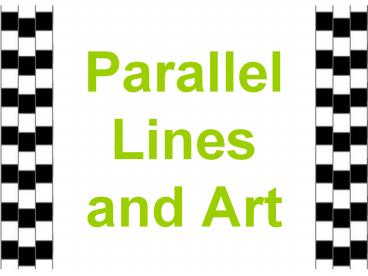Parallel Lines and Art - PowerPoint PPT Presentation
Title:
Parallel Lines and Art
Description:
Parallel Lines and Art Objectives To apply parallel lines to construction, technical drawing and art There are three tasks you are going to be asked to do today: Task ... – PowerPoint PPT presentation
Number of Views:141
Avg rating:3.0/5.0
Title: Parallel Lines and Art
1
Parallel Linesand Art
2
Objectives
- To apply parallel lines to construction,
technical drawing and art - There are three tasks you are going to be asked
to do today - Task 1 Geometric Construction of Parallel Lines
- Task 2 Parallel Projection Elevation, Oblique,
Isometric - Task 3 Obstacle Drawing
3
Geometric Construction
- In geometry, constructions utilize only two tools
- the straightedge (an unmarked ruler) and the
compass. - Never draw freehand when doing a construction!
- The compass
4
Task 1 Construct Parallel Lines
- Step 1
- Put point A on line
- Draw a line through points P and A
. P
. A
5
Task 1 Construct Parallel Lines
Step 2 Find the center of the circle thing on
your compass and place it the center on point A.
6
Task 1 Construct Parallel Lines
Step 3 Adjust the moving thing to about 3 on
the ruler. Then make an arc off of point A
. P
. A
7
Task 1 Construct Parallel Lines
Step 3 Do the same thing at point P
. P
. A
8
Parallel Projection
- Parallel transformation of points.
- The perspective transformations that describe how
a point in three space is mapped to the drawing
plane can be explained using elementary geometry.
- Begin by setting up coordinates. A projection
involves two coordinate systems. A point in the
coordinate system of an object to be drawn is
given by X(x,y,z) and the corresponding in the
imaging system (on the drawing plane) is P(u,v).
- If we use the standard right handed system, then
x and y correspond to width and depth and z
corresponds to height. On the drawing plane, we
let u be the horizontal variable and v the
vertical.
http//www.math.utah.edu/treiberg/Perspect/Perspe
ct.htmParallelx
9
Parallel Projection
- The most frequent parallel projections are called
elevations, oblique projections and isometric
projections. - To illustrate, let's begin with an object in
three space, say a simplified house.
10
Parallel Projection Oblique Projections
- In oblique projection (Cavalier projection), the
front view is undistorted, but the sections of
the object are drawn up and to the right
depending on how far back you go - Of course horizontal and vertical lines also
preserve measurement.
11
How do draw an oblique letter
- Start with a block letter that has ½ inch
thickness - http//www.mmwindowtoart.com/wordart/lettering5.ht
ml - Then choose a length on your ruler - I chose an
inch - Off of every corner draw a line either off to the
left or right - what do you notice about all the
lines that go off the corners?
E
12
How do draw an oblique letter
- Erase the parts that go through the letter
- Then connect the parallels to the front pieces
E
13
Parallel Projection Elevations
- The elevations are just the front, top and side
views of the object.
14
Elevations of your letter
- Look at your letter from the top
15
Parallel Projection Isometric Projections
- The isometric projections are that class or
parallel projections for which a round sphere
projects to a round circle. The most common case
is when measurements along the x-axis are plotted
at 30, those along the y axis at 150 and the
vertical axis.
x-axis
16
Task 2 Create a Parallel Projection
- Use a straight edge for straight line and a
compass for curves - Using the first letter of your name
Oblique
17
Task 2 Create a Parallel Projection
- Use a straight edge for straight line and a
compass for curves - Using the first letter of your name
Top view
Elevations
Front view
Side view
E
E
18
Task 2 Create a Parallel Projection
- Use a straight edge for straight line and a
compass for curves - Using the first letter of your name
Isometric
E
19
Obstacle Line Drawings
- Where "line as movement" is curvilinear and
softly dances across the page, "Obstacle Line" is
angular, sharp and intense as it circumscribes
the "obstacles" in the composition. These
"obstacles" can be words, numbers, images, icons,
etc. and are first collaged or painted on to the
background. Since lines in this design close upon
themselves, shapes are created.
http//www.mmwindowtoart.com/foundations/obstaclel
ine.html
20
Obstacle Line Drawings
- Where "line as movement" is curvilinear and
softly dances across the page, "Obstacle Line" is
angular, sharp and intense as it circumscribes
the "obstacles" in the composition.
http//www.mmwindowtoart.com/foundations/obstaclel
ine.html
21
Obstacle Line Drawings
- Better example
http//www.mmwindowtoart.com/foundations/obstaclel
ine.html
22
Obstacle Line Drawings
- Rules The lines never "blend" or touch each
other. They are always parallel. They are as
intricate in detail as their curvilinear cousin,
depending upon the movement and alignments the
designer conceives. The linear effect is like a
maze and often results in op-art illusionary
motions.
http//www.mmwindowtoart.com/foundations/obstaclel
ine.html
23
Task 3 Create an obstacle drawing
- Use at least the following in your drawing
- 2 numbers
- 2 letters
- 1 symbol/shape
24
Summary
- Construct a parallel line
- Oblique letter
- Elevation of letter (top, side, front)
- Isometric (2 pt. perspective)
- Obstacle drawing (2 letters, 2 numbers, 1 symbol)
E































